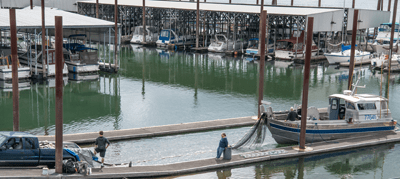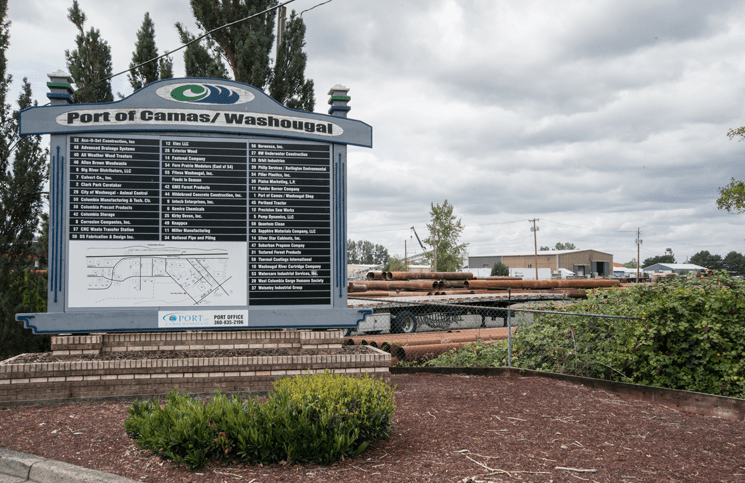The ring of hammers, the bustle of machinery… it’s a busy time at the Ports of Camas-Washougal and Skamania County, the two ports that serve the easternmost reaches of Southwest Washington.
Port of Camas-Washougal
David Ripp, executive director for the Port of Camas/Washougal, said they are building a second, 25,000-square-foot building in the Steigerwald Commerce Center.
“It was completely leased before we started construction,” said Ripp.
 Three tenants will occupy the $2.5 million dollar project. Foods in Season, which already leases 21,300 square feet at the Commerce Center, will occupy 13,500 square feet in the new building, and has recently added eight employees, bringing the total to 38. The other two tenants will be Lumino Wellness and Mary Jane’s House of Glass. The latter is already a manufacturing tenant of the port, but will use 5,400 square feet of storage in the new building.
Three tenants will occupy the $2.5 million dollar project. Foods in Season, which already leases 21,300 square feet at the Commerce Center, will occupy 13,500 square feet in the new building, and has recently added eight employees, bringing the total to 38. The other two tenants will be Lumino Wellness and Mary Jane’s House of Glass. The latter is already a manufacturing tenant of the port, but will use 5,400 square feet of storage in the new building.
Other projects in motion at the Camas-Washougal port include the $2.6 million Washougal Waterfront Trail and Park project, located on the former Hambleton Lumber site, and permitting replacements for hangers that burnt last October at Grove Airfield. Ripp hopes the park construction will start soon; they are awaiting a $1.7 million grant agreement from the Washington State Recreation Conservation Office (RCO). The first phase of the project will consist of a 7/10-mile trail. It is the port’s hope that the city of Washougal will complete phase 2 of the project, which would tie the new trail to the existing levy trail. The hangar project will commence construction late this year.
Port of Skamania
Further east, the Port of Skamania is equally abuzz with activity. The port owns or manages 350 acres of commercial, industrial and recreational land, including three business parks, the Stevenson waterfront and the Beacon Rock Golf Course. The port’s buildings total 260,000 square feet.
John McSherry, executive director for the Port of Skamania, said that the port has recently invested $2 million in infrastructure (access roads, sewer, water, power and fiber optic networks) at the 30-acre Cascade Business Park in North Bonneville, and is currently developing a marketing strategy for that property. In the nearby 5-acre Lewis & Clark Business Park, an existing port tenant is expanding into the last remaining lot. McSherry said the port is in the process of designing a 15,000-square-foot building for that lot, and hopes to start construction this year. That new building will bring the Lewis & Clark square footage to just over 60,000 square feet.
Further north, the 186-acre Wind River Business Park (former Wind River Nursery) is home to Wind River Biomass LLC, as well as Sherman Technical Industries Inc., which makes circuit boards, and Last US Bag. The port is now designing improvements to the water system, including installing an additional well.
And on the waterfront, McSherry said they are repaving Cascade Avenue and installing quad gates at the railroad crossing at Russell Street.
“The quad gates will allow the train to not blow its whistle when it goes through town,” said McSherry. “It’s going to be huge.”
The port is also reroofing its largest industrial building (50,000 square feet), and received a $350,000 RCO grant to replace the waterfront pathway and create another beach and non-motorized boat launch.
A fight for funding
Both ports’ mission is to create jobs. And at both ports, the challenges center around funding.
“We’ve got enough demand for another building, but need help financially,” said Ripp. “We’re not in dire straits, but there used to be other grants for economic development – now they are so difficult to apply for…”
Ripp added that he doesn’t think the state of Washington has a very good incentive program, compared to other states.
“As the cost of permits and impact fees go up, it costs us more to create more jobs,” he stated.
McSherry had similar thoughts, stating that “the challenge is getting it all done – we’re such a small port with limited resources.”
Backwoods Brewing Company leased the last available square footage available on the waterfront in late August; the only available space at the Port of Skamania is now 10,000 square feet of office space that is wired for a call center.
“Building more space is tough because of limited cash,” said McSherry. “Our bonding is limited to taxable property in the port district – a lot of our land is undeveloped or forest land, so there is very little property value to underwrite the bonding.”
McSherry said the Port of Skamania “uses grants a lot to leverage what dollars we do have.” Recent grants received by the port include a $900,000 grant from the U.S. Department of Commerce and a $300,000 grant/$700,000 low-interest loan combination from the Washington state Department of Commerce’s Community Economic Revitalization Board (CERB). But McSherry admitted that coordinating grants – and completing the paperwork – was daunting.
Environmental permitting is also something that poses challenges, according to Ripp.
“We want to be clean and green, but we have to dredge our marina,” he said.
In 2009, he explained, the port dredged the marina, and the permit was good for 10 years. So, it’s logical to assume the port could dredge again in 2016. But think again. New species (such as smelt) have been added to the biological evaluation requirements.
“It’s going to take two years to re-permit a permit we already had, and we are spending another $60,000 to go through this whole process,” said Ripp.
In addition, the allowable dredging work window has been changed from November/January to August/November. But the port can’t dredge the marina at the height of boating season.
“They’re cutting us shorter and shorter – it makes it hard to maintain something that’s been here since 1935,” said Ripp.
However, despite budgetary and regulatory challenges, both ports are revving their economic engines.
McSherry stated that since he started keeping statistics in 2006, the Port of Skamania’s square footage has doubled and its cash has quadrupled. Revenues have gone from $300,000 to a $1 million. At the Port of Camas/Washougal, industrial park operating revenues have steadily increased over the last five years, increasing 13 percent 2013 to 2014 and 5 percent 2014 to 2015. According to Scott Bailey, regional economist, Port of Camas/Washougal tenants employed a total of at least 711 people in 2014, while McSherry estimates that at least 150 people are employed by Port of Skamania tenants.
Both ports’ executive directors are excited about their respective ports’ future. Ripp is looking forward to the completion of the Steigerwald Commerce Center building in February 2016, while the Port of Skamania has recently attracted four new businesses, and is working on more.










